Results 1 to 10 of 11
Hybrid View
-
01-02-2017, 11:45 PM #1
 Blue/Yellow Belgium? Or a Coticule?
Blue/Yellow Belgium? Or a Coticule?
My friend Helge picked this rock up for me over there in Germany and I started learning it and found it gave a nice edge/especially to the Sheffield razors that reside here.
Helge refers to it as a 'Belgium Yellow Blue'.
However my honing experience is minimal compared to many others such as my friend GSSIXGUN so I sent it to him for evaluation. I got a good report back and Glen referred to my little hone as a 'Coticule'.
However I believe he like I had just used the 'Yellow' side of the hone.
The 'Blue' is actually more of a really deep purple/almost black.
I was wondering what others With Experience with a similar hone could tell me about the 'Blue' side/bevel setting perhaps with some slurry?
Here's some pics of the rock;
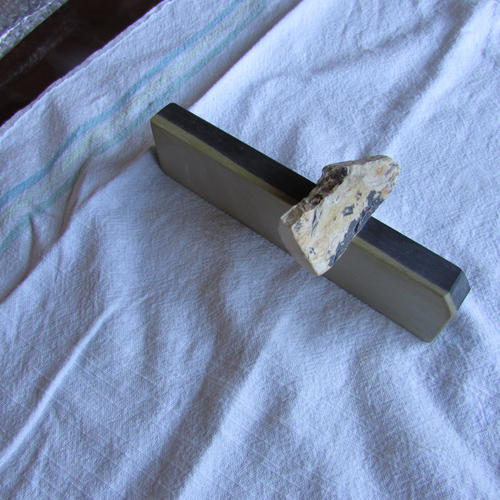
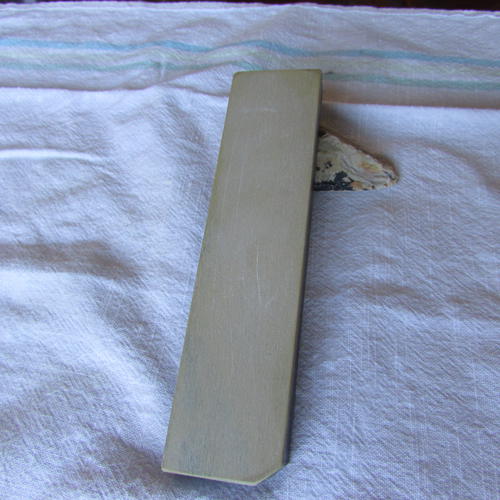
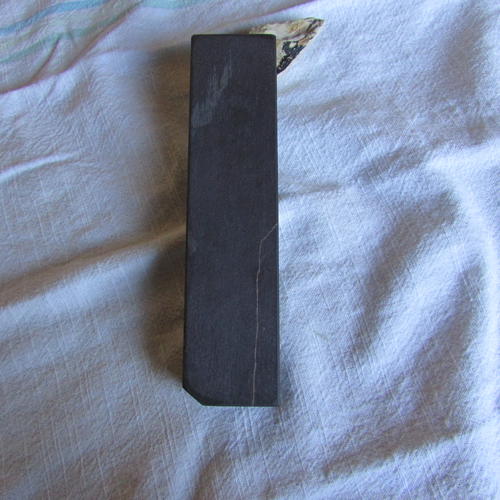
Thanks for taking a look and a Special Thanks for those that have similar rocks who join in. :
:  Our house is as Neil left it- an Aladdins cave of 'stuff'.
Our house is as Neil left it- an Aladdins cave of 'stuff'.
Kim X
-
The Following User Says Thank You to cudarunner For This Useful Post:
Iceni (01-03-2017)
-
01-02-2017, 11:54 PM #2

They vary, being naturals. The blue is typically "lower grit," but may also have a slower cutting speed. You'd have to play with your coticule (yellow side) and blue with slurry on each to see what their speeds and finishes are like. If you search on the forum, they are referred to as Belgian Blue Waterstones, or BBW for short.
-
The Following 2 Users Say Thank You to holli4pirating For This Useful Post:
cudarunner (01-03-2017), doorsch (01-03-2017)
-
01-03-2017, 12:07 AM #3

Belgian blue some would say are great. I would say if you've got a yellow coticule the blue side is useless other than to support the precious yellow side.
The thing about the blue is it is beyond slow. I have had many Belgian blue stones in the past and they are all gone. Why? Inferior to the yellow, and redundant.
By all means have fun playing with it but make sure you stretch your elbow so you avoid developing tennis elbow. If you want to set a bevel my lord. I pray for you friend. Pray that the bevel is almost set. Slurry doesn't speed it up too much.
Try back honing with a Belgian blue or use pressure. "Speeds it up" a little.
They did a study over at coticule.be on the merits of a Belgian blue for razor honing. Take a look http://coticule.be/heritage.html?fil.../BBW-study.pdf
Let us know.
As an aside BBW is great for kitchen knives
Last edited by s0litarys0ldier; 01-03-2017 at 12:14 AM.
-
The Following User Says Thank You to s0litarys0ldier For This Useful Post:
cudarunner (01-03-2017)
-
01-03-2017, 12:10 AM #4

I fully understand how naturals vary even rocks cut side by side.
Perhaps I didn't word my question properly however you have touched on what I was wondering about :. Has anyone used the 'Blue' side for setting a bevel? Or any other kind of non finishing razor work?
Our house is as Neil left it- an Aladdins cave of 'stuff'.
:. Has anyone used the 'Blue' side for setting a bevel? Or any other kind of non finishing razor work?
Our house is as Neil left it- an Aladdins cave of 'stuff'.
Kim X
-
01-03-2017, 12:23 AM #5
 Blue/Yellow Belgium? Or a Coticule?
Blue/Yellow Belgium? Or a Coticule?
Actually we have to difference a bit. There is always a bit of discussion about the backing side or the natural grown side....sure the glued black slate in general is more or less useless...
But then there sometimes happens something magical made by nature and this is that each stone is different then the other.
Geologically speaken there are two different stones, one called Belgian Blue Water Hone (BBW) and one which is called a Rouge Du Salm. Its proven that those types are near "brothers" but both are a bit different.
Now back to the question, Setting a Bevel on a BBW?
I would say in many cases, no...but this doesnt mean its not possible, i did it myself, but if you see the procedure to set a bevel with a thick slurry fex. its a lot more time consuming and complicated compared to what it would need to do it with a coarser synthethic stone.
Setting the Bevel on a Lorraine?
In some cases yes, i had often the feeling that these stones work fairly faster with a thick slurry. But also here might be another natural or synthethic stones a better choice to set the bevel...
In the end its totally up to you how you wanne play the game...just try out and report back if you had a good result doing it.Last edited by doorsch; 01-03-2017 at 12:26 AM.
███▓▒░░.RAZORLOVESTONES.░░▒▓███
-
The Following 2 Users Say Thank You to doorsch For This Useful Post:
aaron1234 (01-04-2017), cudarunner (01-03-2017)
-
01-03-2017, 12:23 AM #6

Regarding BBW for bevel setting, they are slower - sometimes much slower - than the coticule with slurry. Some people use the BBW in between using the coticule with slurry and the coticule with water, but in my personal experience, it doesn't offer any advantages. The fastest cutting will always be the yellow coticule with straight slurry, and the best finish will come from the yellow coticule and plain water. The most efficient use is to do your cutting with undiluted slurry, then dilute the slurry to refine the edge, and then finish on plain water; all on the yellow coticule. BBWs are popular with some for knives and other tools. The quarry sells them in part because for every ton of coticule in a vein, there are many tons of BBW. This photo is a good example, the coticule layers are very thin and sparse compared to the main rock, which is BBW.
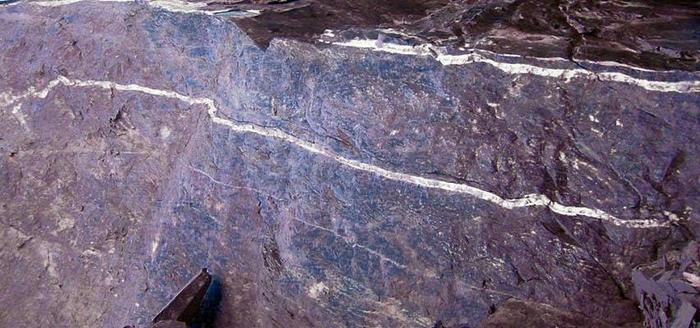 "Every normal man must be tempted at times to spit on his hands, hoist the black flag, and begin to slit throats." -H. L. Mencken
"Every normal man must be tempted at times to spit on his hands, hoist the black flag, and begin to slit throats." -H. L. Mencken
-
The Following User Says Thank You to sqzbxr For This Useful Post:
cudarunner (01-03-2017)
-
01-03-2017, 12:45 AM #7
 Blue/Yellow Belgium? Or a Coticule?
Blue/Yellow Belgium? Or a Coticule?
I did some comparison shots of the BBW and the Rouge Du Salm.
Typical for the Salm is a reddish wine red coloration of the slurry. Also the stone itself appears more red then blue. Sometimes orange spots appear as visible on the first picture.
The polishing up the bevel in most cases appears much more fine and pronounced.
new Age Salm from Ardennes:
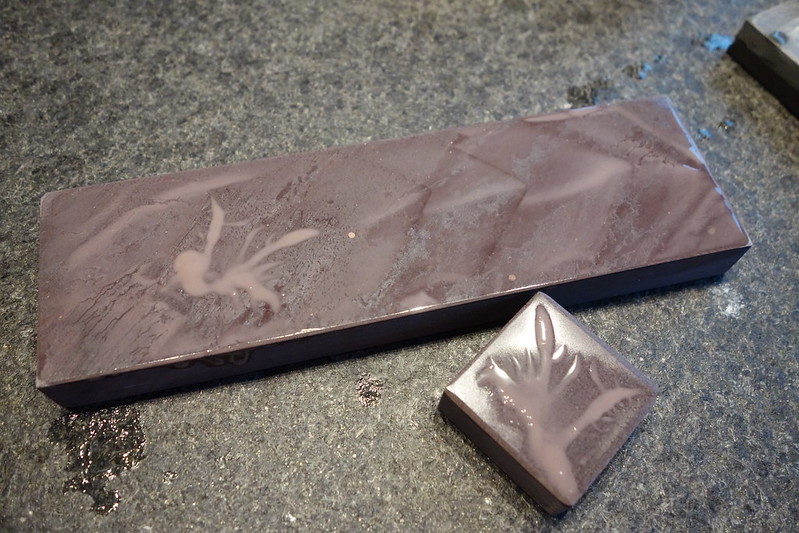
Comparison shots of three Rouge Du Salm (left) and two darker violet looking BBWs (right). The left one is the most finest Salm i own, you can also see it how the structure looks like. Very fine grained..
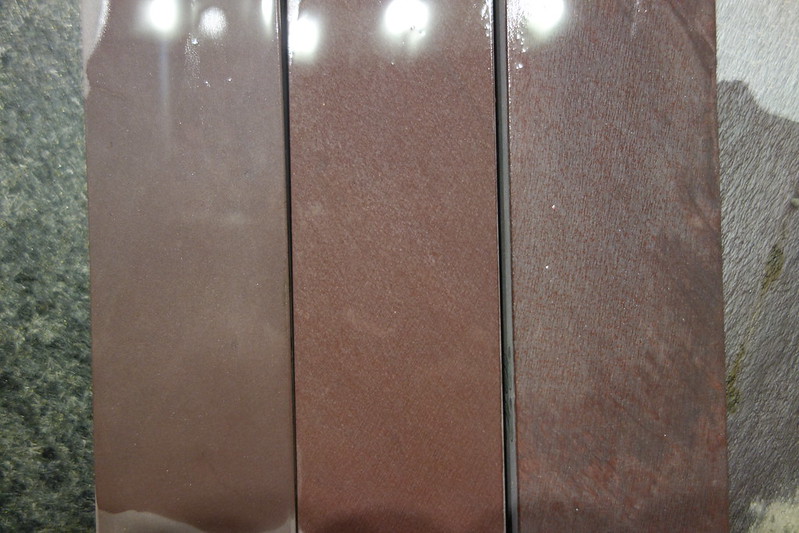
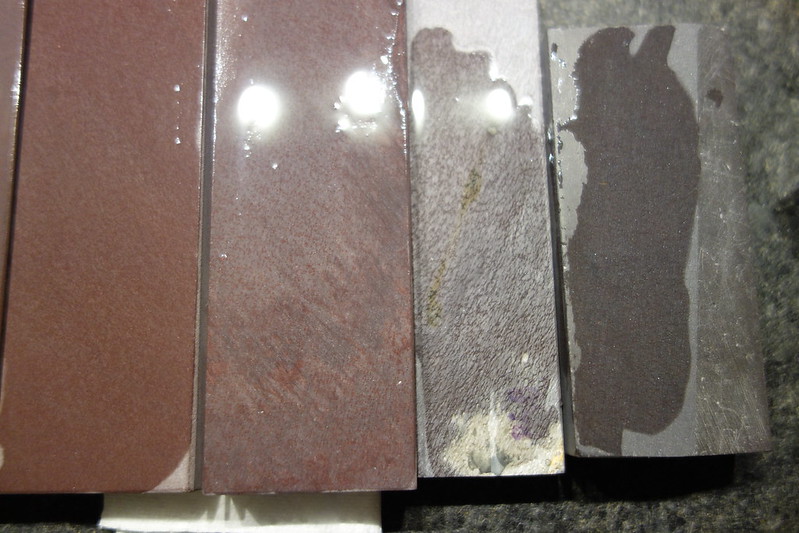
Sometimes white lines or white inclusions can appear:
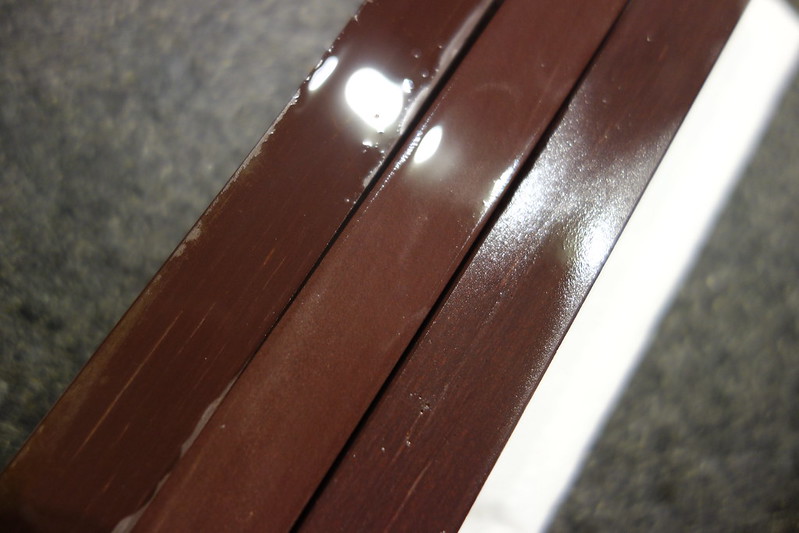
Thats probably a good shot to see the differences quite easy...
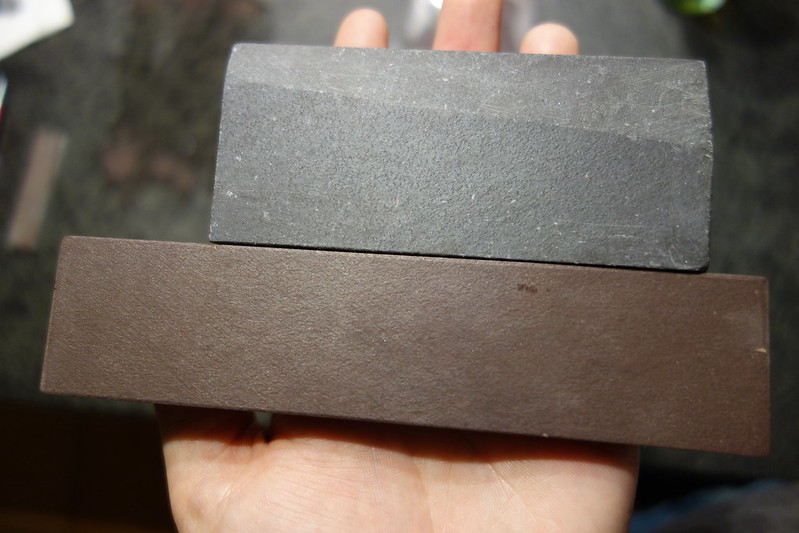
Last edited by doorsch; 01-03-2017 at 12:51 AM.
███▓▒░░.RAZORLOVESTONES.░░▒▓███
-
01-03-2017, 12:55 AM #8

Thank you for taking the time to make the slurry and post the pictures!
 :
:
After reviewing the pics and making a slurry on my little hone I'm confident that my hone is close to the pics on the Bottom far right of the original pictures supplied although the grain on my 'Blue' runs very close to straight up and down lengthwise.
When the time comes I'll 'Play' and let all know how things go. Again Thanks!
Last edited by cudarunner; 01-03-2017 at 01:20 AM.
Our house is as Neil left it- an Aladdins cave of 'stuff'.
Kim X
-
The Following User Says Thank You to cudarunner For This Useful Post:
doorsch (01-03-2017)
-
01-03-2017, 11:36 AM #9

Generally getting a good BBW on a coticule is just a nice bonus. The coticule what you want for finishing in 99.9% of cases. There are some exceptional BBW that can finish. These are rarities.
Speed wise there are some really fast BBW's. Just because they have fewer garnets doesn't make them slower. My coti is slow and a very fine finisher so I will often use the BBW to take the razor from 1K.
It's all trial and improvement with coti's you probably want to start with a 12K finished razor at first and use the yellow side with a very light slurry. You should be able to tell pretty quickly if it's a fast rock or a slow one. And with that information you can go trawling threads to see how people with similar behaving rocks get the best edges. My own rock is very slow on slurry, and almost glassy on water. Because of this I only use it as a finisher. Faster rocks you can do a lot more with but you will have to find the finesse to get the perfect finish.Real name, Blake
-
01-04-2017, 12:12 PM #10

Belgian blue stones are fun to use, but they cannot do anything a coticule cannot do faster (generally speaking). You can set a bevel (on a decently maintained, but dull edge), but it will take some time. However, if you're in dire need of some zen time, I can highly recommend this.
Funny thing, Belgian blue stones tend to set a keener bevel than a coticule, as the keenness threshold on the blue stone with slurry is higher (again, generally speaking), probably due to the lower spessartine garnet density. This threshold drops on water only, where the blue stones are dead slow, bordering on ineffective.


 15Likes
15Likes LinkBack URL
LinkBack URL About LinkBacks
About LinkBacks








 Reply With Quote
Reply With Quote


